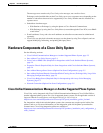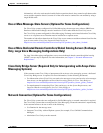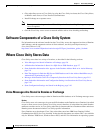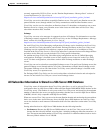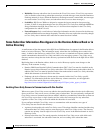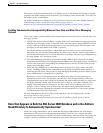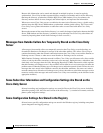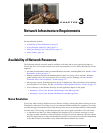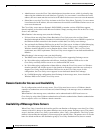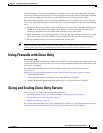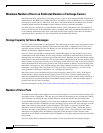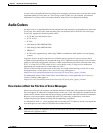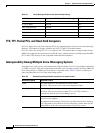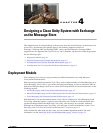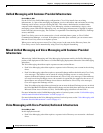
CHAPTER
3-1
Design Guide for Cisco Unity Release 5.x
OL-14619-01
3
Network Infrastructure Requirements
See the following sections:
• Availability of Network Resources, page 3-1
• Using Firewalls with Cisco Unity, page 3-3
• Sizing and Scaling Cisco Unity Servers, page 3-3
• Audio Codecs, page 3-5
Availability of Network Resources
The following network resources must be available at all times and in close physical proximity to
Cisco
Unity (over a local area network, not a wide area network), or Cisco Unity functionality will be
impaired:
• All name resolution hosts used by standard Windows networks, including DNS hosts. See the “Name
Resolution” section on page 3-1.
• Domain controllers that provide authentication for the Cisco Unity service accounts. Windows
global catalog servers are also necessary if Cisco
Unity services Exchange. See the “Domain
Controller Access and Availability” section on page 3-2.
• Message store servers. Each message store server on which Cisco Unity subscribers are homed must
be accessible to Cisco
Unity. See the “Availability of Message Store Servers” section on page 3-2.
• Active Directory or the Domino directory. See the applicable chapter in this guide:
–
Designing a Cisco Unity System with Exchange as the Message Store
–
Designing a Cisco Unity System with Domino as the Message Store
Name Resolution
Cisco Unity must be able to find the servers it interacts with by resolving the names of those servers to
IP addresses, unless the Cisco
Unity server is not connected with the network. For example, Cisco Unity
can send messages from outside callers to the message store server on which the mailbox of the recipient
is homed only if Cisco
Unity can find that message store server. Name resolution is also used when:
• A subscriber uses the Cisco Unity telephone user interface (TUI) to listen to messages or send
messages to other subscribers. Name resolution is used by Cisco
Unity whenever a process requires
the Unity application to execute commands that leave the Cisco
Unity server and access information
across the network to the mailbox stores where subscriber mailboxes are located.



